PDF version
Archived
This profile presents a short summary of how enterprises operating in Canada were involved in global value chains (GVCs) between 2007 and 2009, using the data from the Survey of Innovation and Business Strategy 2009 (SIBS).
The international commerce profile of enterprises in Canada that emerges from the SIBS questions on global value chains is clearly more sophisticated than a simple export story. Enterprises operating in Canada, and manufacturing enterprises in particular, are active in other countries through a range of business activities and for a variety of reasons. Furthermore, their international operations display considerable fluidity with activities moving outside and back within Canadian borders during the period in question.
Description of the SIBS
The SIBS is a joint project undertaken by Industry Canada, Foreign Affairs and International Trade Canada and Statistics Canada. It was initiated in 2007–2008 to better understand the market and policy factors that encourage or discourage the adoption of entrepreneurial and innovation-oriented business strategies. In addition to detailed information about GVCs, the SIBS provides information about the various business strategies, innovation activities, competitive environments and marketplaces of enterprises in Canada. A more detailed analysis of these topics, including GVCs, will be available in the upcoming Industry Canada report on the SIBS, targeted for Spring 2011.
A sample of 6,233 enterprises in Canada, each with more than 20 employees, and spanning 67 industries were surveyed. As a result, SIBS results are representative of all enterprises in Canada with more than 20 employees and revenues of at least $250,000 in the selected industries. The overall survey response rate was 70%. A more detailed description of the SIBS is available on the websites of Industry Canada and Statistics Canada.
How did enterprises operate outside of Canada?
Building on a number of free trade agreements that facilitate the exchange of goods between countries, Canada has become an open economy with high trade intensity in several industries, especially in the manufacturing sector. Figure 1 shows that 53.7% of manufacturing enterprises indicate they exported or attempted to export goods or services between 2007 and 2009.
The SIBS also includes questions about the location and changes in the location where enterprises conducted their business activities between 2007 and 2009. Figure 1 shows that enterprises undertake a wide range of business activities outside of Canada. Over that period, 47.5% of manufacturing enterprises report that they conducted business activities outside of Canada. Figure 1 also includes relocation and outsourcing of business activities. Relocation refers to displacing business activities outside of Canada, but within the enterprise, while outsourcing refers to contracting these activities outside the enterprise. Over 2007–2009, 5.2% of manufacturing enterprises relocated business activities and 10.1% outsourced them.
While globalization is often associated with the displacement of business activities from Canada to other countries, the SIBS data shows that some business activities were returned to Canada. As shown in Figure 1, 5.0% of manufacturing enterprises relocated business activities from another country into Canada between 2007 and 2009.
Figure 1: Degree of International Involvement of Enterprises Operating in Canada — Canada, Manufacturing Enterprises, 2007–2009
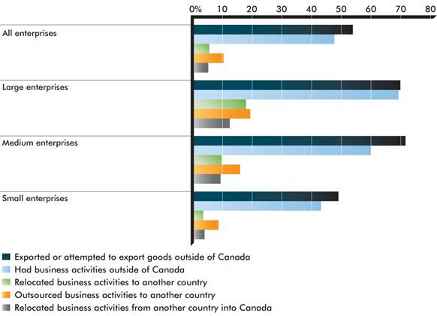
Evidence from Figure 1 suggests that large manufacturing enterprises (those with at least 250 employees) were more likely to be active abroad than small (20 to 99 employees) or medium size manufacturing enterprises (100 to 249 employees) over 2007–2009. The one exception is the higher percentage of medium-size enterprises (71.3%) that exported goods compared to large enterprises (69.8%).
Which business activities were most likely to be outsourced or relocated?
Figure 2 shows the four most displaced business activities by manufacturing enterprises in Canada between 2007 and 2009. Production of goods was the most displaced business activity, both into and out of Canada, by manufacturing enterprises. The next three most displaced business activities were provision of services, distribution and logistics, and marketing, sales and after sales services.
Displacement of high skill activities was also reported. For example, engineering and related technical services was reported as the sixth most relocated activity outside of Canada and the fifth most outsourced outside of Canada (not shown in Figure 2). It was also the fifth most relocated activity into Canada (not shown).
Figure 2 suggests that medium size manufacturing enterprises were more likely than large enterprises to displace production of goods between 2007 and 2009. In contrast, a higher percentage of small manufacturing enterprises displaced marketing, sales and after sales services.
Figure 2: Most Relocated or Outsourced Business Activties
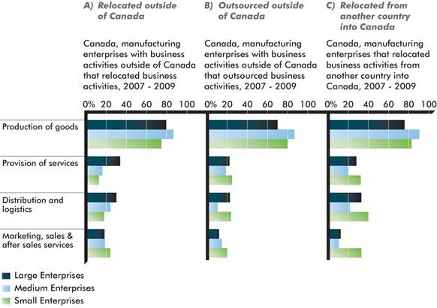
What were the most important destination countries for relocating and outsourcing business activities?
Despite the common view that production of goods is massively outsourced to China and India, Figure 3A shows the most important country for outsourcing business activities in 2007–2009 was the United States, although China was close in second position. The United States was also the most important source country for business activities brought back into Canada (Figure 3B).
More specifically, when asked about their three most important countries for outsourcing business activities abroad over 2007–2009, 39.3% of manufacturing enterprises with business activities outside of Canada outsourced some activities to the United States, 31.4% to China and 12.2% to India. Similarly, 46.8% of manufacturing enterprises that relocated business activities into Canada between 2007 and 2009 did so from the United States.
Figure 3: Most Important Countries for Relocating or Outsourcing Business Activities
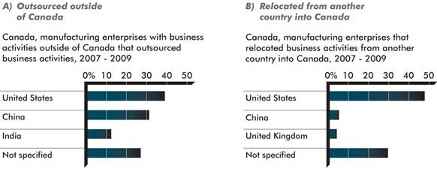
Source: Survey of Innovation and Business Strategy, 2009.
How have enterprises integrated into the global market?
Two illustrations of how enterprises in Canada have integrated into the global economy in 2009 are their suppliers' location and how they exported their goods. Enterprises in Canada can benefit from sourcing abroad by buying more appropriate or less expensive inputs. Moreover, enterprises can take advantage of existing supply chains to export their products in new ways.
Figure 4 shows that nearly all manufacturing enterprises in Canada had suppliers in Canada in 2009. A majority of manufacturing enterprises also had suppliers located in the United States, with the proportion decreasing with firm size: 94.3% for large enterprises, 86.1% for medium-size enterprises, and 69.8% for small enterprises. Like the numbers in Figure 3, these percentages emphasize the importance of the United States as a trading partner for Canada.
Figure 4 also shows that the percentages of enterprises with suppliers in Europe and Asia Pacific are roughly equal. They are also about half of the percentages for the United States, irrespective of firm size.
Figure 4: Location of Suppliers, by Region — Canada, Manufacturing Enterprises, 2009

Source: Survey of Innovation and Business Strategy, 2009.
Figure 1 shows that a majority of manufacturing enterprises exported goods outside of Canada. However, not all enterprises exported goods in the traditional way, i.e. by selling the goods they produced directly to foreign customers.
The evidence presented in Figure 5 suggests that many enterprises exported goods indirectly in 2009. Around 20% of manufacturing enterprises sold their goods to another enterprise in Canada which, in turn, exported them as-is and 25% sold goods to another enterprise in Canada that used them as intermediate inputs in final goods that were then exported abroad. Small manufacturing enterprises were more likely than large enterprises to have their goods exported by another enterprise but less likely to produce intermediate inputs for goods that would subsequently be exported. It should be noted that these figures represent a conservative assessment of indirect exporting as more than a quarter of manufacturing enterprises reported that they did not know if their goods were exported by another enterprise as-is, or used as intermediate inputs in final goods which were then exported.
Enterprises in Canada can also act as intermediaries by buying and selling goods without having them entering Canada. Figure 5 shows that 14.6% of large manufacturing enterprises did so in 2009, a proportion higher than for than that of medium (10.6%) and small enterprises (5.4%).
Figure 5: Indirect Exports — Canada, Manufacturing Enterprises, 2009
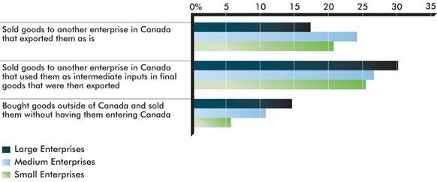
Source: Survey of Innovation and Business Strategy, 2009.
What are the barriers and motivations for enterprises conducting business activities abroad?
The highlights of the SIBS published in Fall 2010 show that distance to producers, trade tariffs and the difficulty in identifying potential suppliers were the main barriers faced by manufacturing enterprises when entering into GVCs between 2007 and 2009. Figure 6 shows that, over the same period, the main reason for relocating or outsourcing business activities was to achieve cost reductions for a majority of manufacturing enterprises.
A higher proportion of small manufacturing enterprises report that access to new markets,improved logistics and reduction of delivery times were important reasons to move activitiesabroad compared to larger enterprises. Although not reported in Figure 6, this was also the casefor some other reasons such as tax and other financial incentives along with access to specialized knowledge or technologies.
Figure 6: Most Important Reasons for Relocating or Outsourcing — Canada, Manufacturing EnterprisesFootnote 1, 2007–09
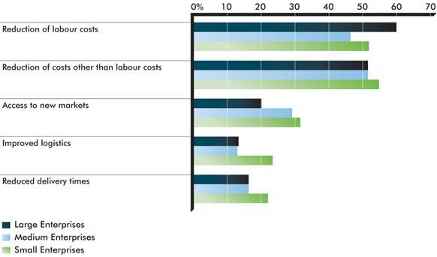
Source: Survey of Innovation and Business Strategy, 2009.
